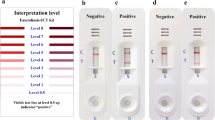Abstract
The present study was aimed to select the specificity of antigens for Fasciola gigantica depending on its diagnostic utility and field applications. The tested antigens were coproantigen, excretory–secretory (ES) antigen and egg antigen. Coproantigen and Copro Hyperimmune serum were able to reflect the lowest level of cross-reaction with other tested F. gigantica antigens. By using SDS-PAGE, a structural homology was observed in F. gigantica ES and egg antigens. Intense cross reaction was observed between ES and egg antigens by ELISA technique even when there was no cross-reaction with coproantigen. The 27.6 kDa band proved to be the most specific in F. gigantica coproantigen and was different from the band at the same molecular weight by ES antigen. The results conclude that coproantigens show specific diagnostic ability for Fasciola and have low numbers of cross-reaction proteins reflecting its high specificity. Moreover, detection of coproantigen in faeces offers a new potential for diagnostics as compared to serum samples. This fact holds promise for a more accurate diagnostic technique in the near future for suspected Fasciola infection.

Similar content being viewed by others
References
Abdel-Rahman E, Abde-Megeed K (2000) Molecular identity of major cross-reactive adult antigens in F. gigantica, T. vitulorum and M. expansa. J Egypt Soc Parasitol 30:561–571
Abdel-Rahman E, Abdel-Mageed K, Hassanain M (2000) Structural characterization and immunolocalization of egg antigens cross-reaction with T.vitulorum, F. gigantica and M. expansa mature flukes. J Egypt Soc Parasitol 30:581–591
Dumenigno B, Finlay C (1998) Detection and quantification of Fasciola hepatica antigens in sheep. Rev Cubana Med Trop 50:82–84
El-Bahy M, Malone J, Todd W, Schnorr K (1992) Detection of stable diagnostic antigen from bile and faeces of F. gigantica infected cattle. Vet Parasitol 45:157–167
Espino A, Millan J, Finlay C (1992) Detection of antibodies and circulating excretory secretory antigens of assessing cure of patients with fascioliasis. Trans Royal Soc Trop Med 86:649–651
Espino A, Bzrges A, Dumenigo B (2000) Faecal antigens of F. hepatica potentially useful in the diagnosis of fascioliasis. Rev Panam Salud Publica 7:225–231
Gorman T, Concha V, Fredes F, Alcaino H (1994) Detection of antigens with diagnostic potential in animals with F. hepatica infections. Parasitologia al Dia 18:26–32
Hassan M, Farghaly A, El-Gamal R, El-Ridi A (1989) Cross-reaction in immuno-diagnosis of patients infected with Schistosoma, Fasciola and Heterophyes using ELISA. J Egypt Soc Parasitol 19:845–851
Hassan AA, El-Bahy MM, Abou-Zinadah NY, Shalaby HA (2008) The diagnostic efficacy of Fasciola gigantica coproantigen in naturally infected cattle and buffaloes. J Egypt Soc Parasitol 38:115–130
Hillier G, Galanes M (1988) Identification of 17 kDa F. hepatica immunodiagnostic antigen by the enzyme linked immuno-electrotransfer blot technique. J Clin Microbiol 26:2048–2053
Lowry O, Rosenbrough N, Farr A, Randall R (1951) Protein measurement with Folin-phenol reagent. J Biol Chem 193:265–275
River Marrero C, Santiago N, Hillyer G (1988) Evaluation of immuno-diagnostic antigens in the excretory-secretory products of F. gigantica. J Parasitol 74:646–652
Shalaby H (1998) Some epidemiological and serological studies on fascioliasis. M.V.Sc. Thesis, Faculty Veterinary Medicine Cairo University Cairo Egypt
Shalaby SI, Hassan A, El-Bahy M, Shalaby H (1998) Evaluation of fluctuations of Fasciola species egg shedding during a year using coprological techniques. Egypt. J Appl Sci 13(12):377–388
Siles-Lucas M, Bandera C (1996) Echinococcus granulosus in Spain strain differences by SDS-PAGE of somatic and excretory–secretory proteins. J Helminthol 70:253–257
Towlin H, Stachelin T, Gordon J (1979) Electrophoretic transfer of protein from polyacrylamide gels to nitrocellulose sheets. Procedures and some applications. Proc Nat Acad Sci USA 76:4350–4354
Author information
Authors and Affiliations
Corresponding author
Rights and permissions
About this article
Cite this article
Shalaby, S., El-Bahy, M., Hassan, A. et al. Diagnotic value of some Fasciola gigantica antigens. J Parasit Dis 39, 479–486 (2015). https://doi.org/10.1007/s12639-013-0379-1
Received:
Accepted:
Published:
Issue Date:
DOI: https://doi.org/10.1007/s12639-013-0379-1




